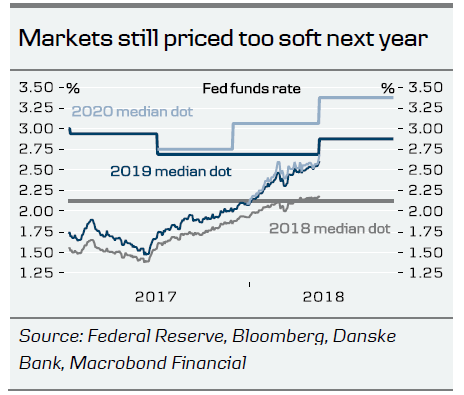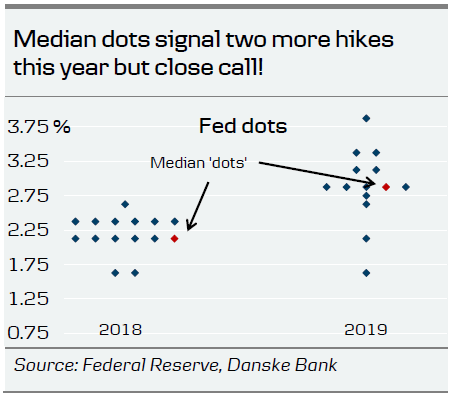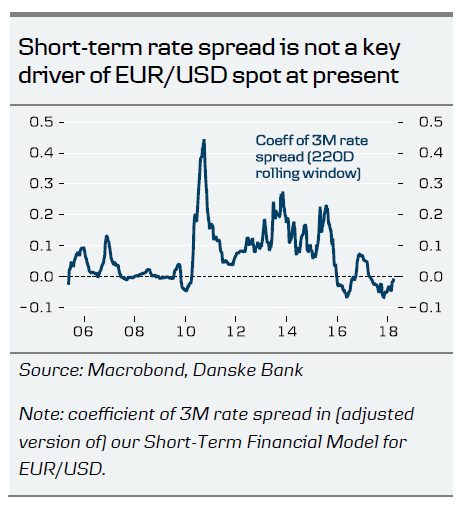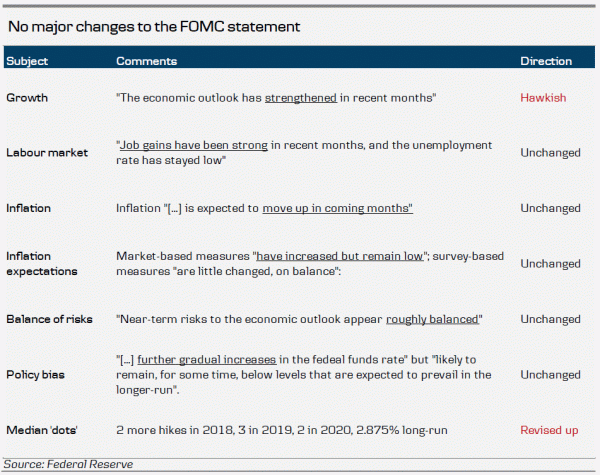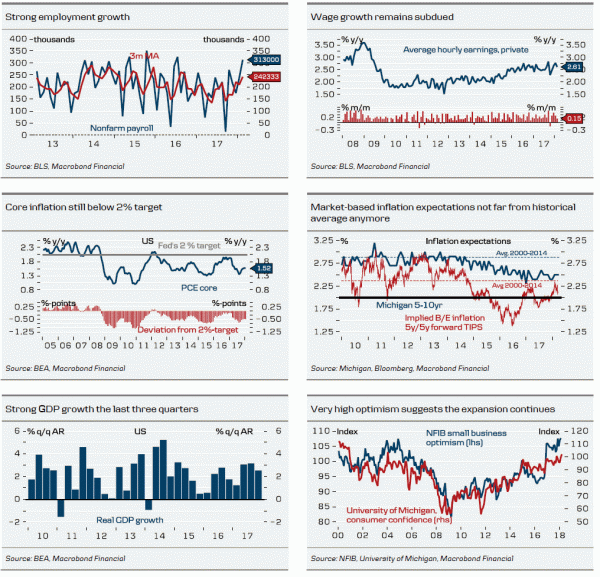- The Fed maintained the three rate hikes signal for this year (close call between three and four) and revised the signal for next year up to three hikes, as expected.
- We still expect the Fed to hike twice more this year but risk is skewed towards a third. We expect three hikes next year. While market pricing for this year seems fair, markets are still pricing the Fed too softly next year, in our view.
- The Fed hike is not set to trigger a new course for the dollar, and we still see EUR/USD in the 1.21-1.26 range near term.
Fed maintains three hikes signal for 2018
As expected by everyone, the Fed raised the target range by 25bp to 1.50-1.75%. More interestingly, the Fed maintained the three rate hikes signal for this year, in line with our expectation laid out in our preview, although it was close between three and four hikes (see chart to the bottom-right). This is important given that some of the most outspoken doves like Bullard, Evans and Kashkari are not voting this year. This supports the view that risk is probably skewed towards a total of four hikes this year. Still this was interpreted dovishly with EUR/USD moving higher and US yields lower. Also in line with our expectation, the 2019 dot was raised from slightly more than two hikes to three hikes, taking the Fed funds target range to 2.75%-3.00% by year-end 2019. The Fed now expects the target range to rise 50bp above the natural rate of interest (the rate where monetary policy neither expansionary nor contractionary) by year-end 2020. The reason for the move up in dots is mainly the more expansionary fiscal policy under Trump. We still believe the overall policy mix is going to be more expansionary, as the Fed seems reluctant to offset more expansionary fiscal policy 1:1.
We still expect the Fed to hike twice more this year (June and December) and three times next year (March, June, September). However, the timing of the rate hikes may also depend on whether Powell decides to make every meeting live by having a press conference at every meeting instead of every other. Indeed, it would make it easier for the Fed to spread out the rate hikes (if the number of hikes is uneven).
As expected, there were no major changes to the statement. The Fed repeated risks are “roughly balanced”, it still monitors inflation “closely” and that it expects “further gradual increases” in the target range. The most important change was that it now says that “the economic outlook has strengthened in recent months”.
Powell said very explicitly the Fed is not about to alter its plan to shrink the balance sheet (unless the outlook deteriorates) and it still has not decided what the appropriate target is. Ultimately, it depends on the demand for the Fed’s liabilities (public demand for currencies and banks’ demand for high quality liquid assets due to regulation).
The Fed discussed trade policy but FOMC members have not changed their economic outlook on back of this. We would likely need to see an escalation of the trade war before that is going to happen. There was no question on the higher LIBOR/OIS spread, so we do not know what the Fed might think about the large increases.
FX: dovish Fed hike does not steer new course for EUR/USD
EUR/USD back above 1.23 as Fed delivered a ‘dovish hike’, largely in the way we had expected. While the risk of a fourth hike remains and the somewhat steeper rate path hinted at by the dots suggests potential for USD support from higher US rates further out, the market is not ready for pricing this just yet. Also, we continue to stress that short-term rates are not a key driver of EUR/USD at present. As we wrote in FX Strategy – EUR/USD risks more two-sided over shorter horizons, EUR/USD has been largely unmoved by notably the recent uptick in Libor rates as the short-rate spread fails to set a course for the pair. This hints that the Fed needs to change its course on policy more dramatically for it to impact USD crosses. Rather, we stress that the risk of USD support over shorter horizons from an uptick in US real yields as the issuance of US Treasuries gains traction is a crucial one to watch going forward. In sum, we expect the March hike will not trigger a new course for the dollar, and we still see EUR/USD in the 1.21-1.26 range near term with focus again set to shift to the Trump administration’s next step on protectionist measures




